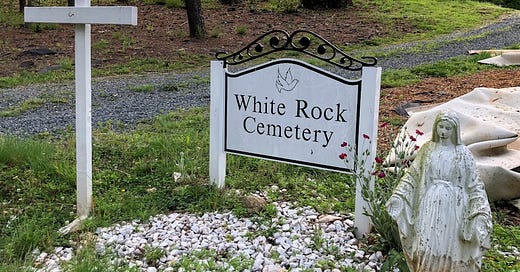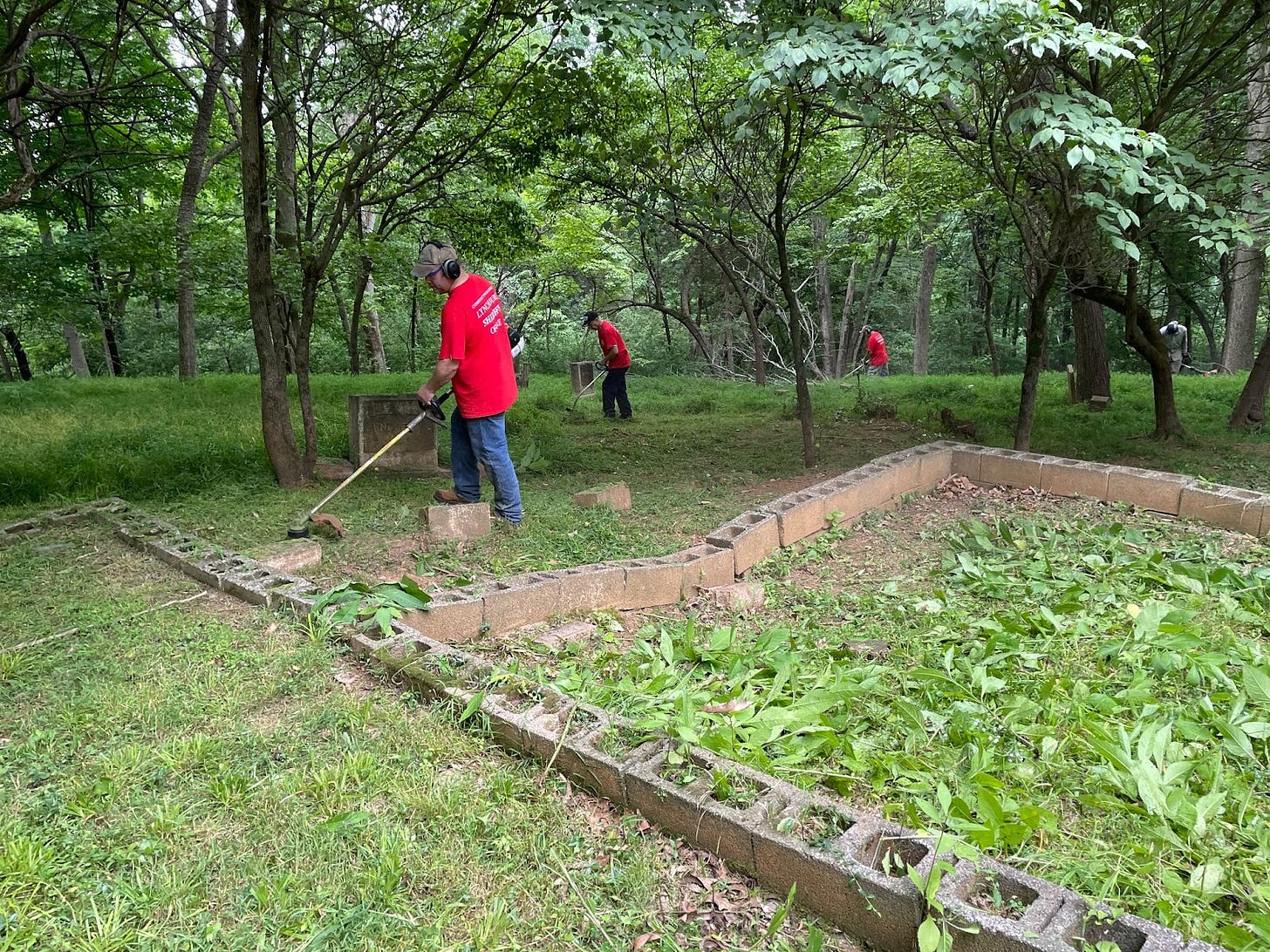Day 10: Tending Life in Death: White Rock Cemetery
Today we lament the inequity we see in death, but we also celebrate the beauty of a sacred grounds and the lives represented here.
Authors Note: Today’s piece kicks off a reflective series on present-day vestiges of enslavement and white supremacy seen in our city, intermixed with the beauty and dignity of personhood.
I love the community activism that seeks to tell the lost stories of our city.
As I pulled into the rutted, gravel White Rock Cemetery entrance on a Saturday not too long ago, I saw stories of both forgottenness and possibility. Headstones shied away from their vertical origin. Many were broken and in disrepair. Thigh high-grass hid many of the stones, and I could tell a significant quantity were unmarked. The expanses of the cemetery faded from my view down wooded slopes, explaining why I had missed the grounds the first time I tried to find it. Four thousand souls are laid to rest here, remembered by a faithful few.
What I didn’t know that day was that the faithful few are a powerful presence.
I had read of this African American cemetery in the city over the years. It sits within the predominantly Black White Rock Hill neighborhood, one of the original “seven hills” of Lynchburg. On a recent excursion to the Lynchburg Library, a flier caught my eye in which trustee Ms. Annabelle Tweedy invited the community to participate in the ongoing work of rejuvenating the cemetery. Before long, I was walking the grounds to see how I could join in.
Historic Jackson Street United Methodist Church (Originally Jackson Street Methodist Episcopal Church) established White Rock Cemetery in 1885, the first independent African American burial ground in the City. It is a 23-acre beautiful, wooded savannah, open grassy areas mixing with widely spaced trees that blend into forest on the borders.
In contrast to the broken stones, disheveled plots, and wild shrubbery of White Rock Cemetery is the Presbyterian Cemetery a few blocks up the road. Presbyterian Cemetery sits on the edge of the Diamond Hill neighborhood and was placed on the National Register of Historic Places in 2004. Its towering monuments dominate the space.
Inside, 12,000 stones are tightly packed in well-groomed organization, fenced by a stately wrought iron boundary with a paved walk inviting the passerby in. The display board a few steps from the main entrance proudly states that 275 Confederate veterans are buried there. Its website describes it as “the place to be buried” for Lynchburg's “most prominent citizens - merchants, tobacconists, attorneys, and others” from 1823 on. The contrast of white supremacy and colored inferiority in our city's history is evident.

But, as I mentioned, the faithful few are powerful. Though historically, White Rock’s families have not benefited from the same public attention and endowments as the wealthier white sons and daughters of the city, champions like Ms. Annabelle Tweedy of Jackson Street Methodist and Diamond Hill Baptist Church continue to care for the grounds. They follow on the heels of the late Laura Munson who, as Tweedy so excellently summarizes, “stumbled upon the Cemetery over twenty years ago in complete neglect, fell in love with its beauty, got busy!”
Other activists and volunteers in the community, including current City Councilman Sterling Wilder, Director of the Lynchburg Museum System Ted Delaney, and the Lynchburg Sheriff’s Office, have continued the legacy of Ms. Munson, by promoting and tending to these unseen graves. They are the graves of people like Thomas Jefferson “Jeff” Anderson (1853–1921), one of the first two Black men elected to Lynchburg City Council (1885), and Ota Benga (c.1885–1916), a Batwa or Mbuti man from the Congo who was brought to Lynchburg to attend Virginia Theological Seminary & College after being exhibited at the Bronx Zoo.

White Rock Cemetery is a place rich in history – but it needs the Lynchburg community to offer more support, both with physical maintenance and financial assistance, to keep the stories alive and share this beautiful setting and historic place with the city. Today, we lament the inequity we see in death, but we also celebrate the beauty of these sacred grounds, in hope that more may know the story of the lives represented here.
I love the community activism that seeks to tell the lost stories of our city.
In our Vision post for Bridge of Lament, we said that “Community has always been crucial for the work of remembrance and lament, for renewal and fullness of joy.” If you are crossing this Bridge with us, we invite you to participate in the community in a tangible way:
Join local Bridge crossers in a gathering at the Cemetery on Saturday, July 1, at 11am, to meet each other, fellowship, pray together, and share each other's stories.
For those with physical means, we encourage you to come early at 9:00 AM to mow the grass, pick up sticks around the grounds, or find other means to beautify the land.
If you are not able to join us, but appreciate this crossing, consider donating to the Cemetery preservation at the address provided at the bottom of this post.
Please also consider joining the larger community for the Laura Munson Cleanup Day on Saturday, July 15th from 8am to 12pm, weather permitting.
Contact Annabelle Tweedy to stay connected: 434-420-8270.
For more information, the Lynchburg News and Advance provided an excellent article on the White Rock Cemetery clean-up day, Mrs. Laura Munson, and the history of the cemetery here.
Donations can be addressed to:
Historic White Rock Cemetery
C/O Jackson St. U.M. Church
P.O. Box 3374
Lynchburg, VA 24502
Questions or feedback? We’d love to hear from you. Email bridgeoflament@gmail.com.








